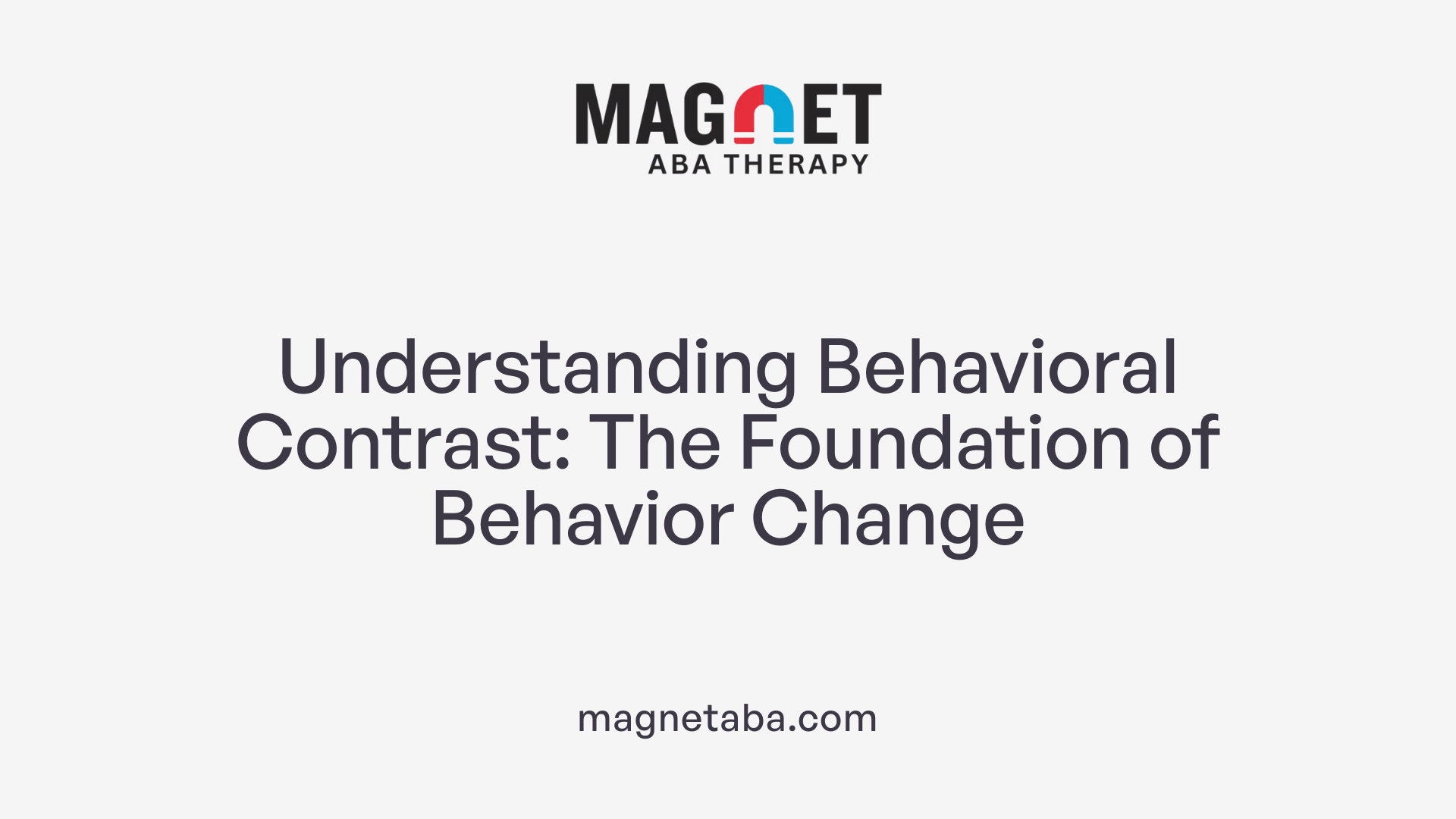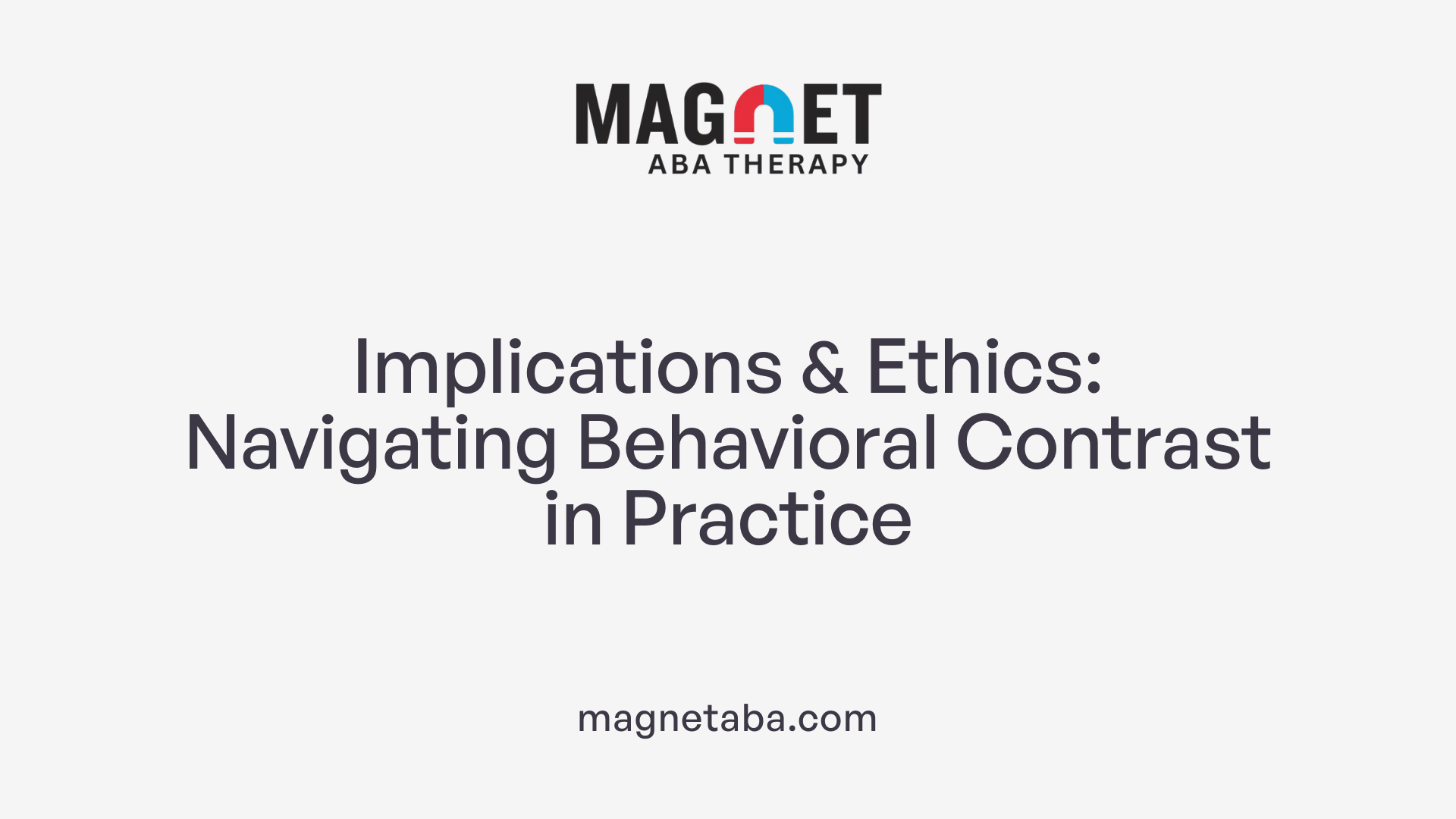Understanding Behavioral Contrast in Behavior Analysis
Behavioral contrast is a vital yet complex phenomenon observed within operant conditioning frameworks. It describes the intriguing ways in which alterations in reinforcement or punishment in one environment can induce opposite behavioral responses in another, seemingly unrelated setting. Recognized extensively through experimental research spanning over decades, understanding behavioral contrast not only enriches the scientific rigor of behavior analysis but also enhances practical intervention strategies. This article delves into the definitions, examples, scientific background, practical implications, and management strategies related to behavioral contrast in ABA.
Defining Behavioral Contrast in ABA

What is behavioral contrast in ABA?
Behavioral contrast is a phenomenon observed in applied behavior analysis (ABA) where changes in reinforcement or punishment conditions in one setting lead to opposite responses in another, unchanged setting. This interplay suggests that behavior is responsive not only to immediate reinforcement but also to the relative context of reinforcement across different environments.
The role of multiple reinforcement schedules
This effect usually occurs within multiple schedules of reinforcement, which involve distinct segments or components that regulate behavior. For instance, a child might eat cookies at the same speed whether or not his grandmother is present. However, if the grandmother punishes cookie eating while she is present, the child's cookie consumption decreases when she's around but unexpectedly increases when she is absent. Such scenarios exemplify how reinforcement conditions across different contexts can produce contrasting behaviors.
Behavioral contrast as an opposite change in response strength
This phenomenon describes an 'opposite' behavior adjustment: when reinforcement becomes less frequent or less rewarding for a response, that response may actually increase (positive contrast). Conversely, when reinforcement intensifies, the response might decline (negative contrast). These shifts have been consistently demonstrated in experiments with animals such as pigeons and rats. Crespi's 1942 studies famously illustrated these effects through changes in reward magnitude, linking to the concepts of 'depression' and 'elation,' later renamed to negative and positive contrast.
Understanding behavioral contrast is crucial for behavior analysts, especially since it affects how behavior might change when reinforcement programs are adjusted across various settings. It underscores the importance of considering the broader reinforcement environment when designing interventions to ensure desired behavioral outcomes.
Illustrative Examples in ABA

What are examples of behavioral contrast in ABA?
Behavioral contrast frequently occurs in applied behavior analysis (ABA) when changes in reinforcement or punishment in one situation lead to opposite changes in behavior elsewhere. A common scenario involves a child who eats cookies at the same rate whether or not their grandmother is present. However, if the grandmother begins to punish or reinforce cookie-eating differently, the child's behavior can change markedly. For example, if cookie eating is punished when she is present, the child's cookie consumption might decrease in her presence but increase when she is absent.
This contrast effect is often associated with multiple schedules of reinforcement, which typically involve different settings or circumstances. In a classroom or home environment, altering reinforcement contingencies in one context can inadvertently cause behaviors to shift in another. For instance, increasing the reward for a specific task might decrease a related behavior that previously received less reinforcement.
Managing Behavioral Contrast
To reduce unwanted effects of behavioral contrast, practitioners often implement strategies such as teaching replacement behaviors that fulfill the same function as the problematic behavior. Consistently punishing or reinforcing behaviors across different environments helps minimize discrepancies that lead to contrast effects.
Minimizing access to reinforcement for problematic behaviors also plays a significant role in stabilizing responses across settings. These approaches aim to create a more uniform reinforcement history, lessening the likelihood of behavioral shifts driven by contrast.
Practical Examples
One example involves a pigeon in an experimental setting: pecking a red key for food increases when the green key's reward rate decreases—this is positive contrast. Conversely, if the reward for green increases, pecking at red tends to decrease, illustrating negative contrast.
Historically, Crespi's experiments in 1942 showed similar effects with rats, where shifting from a large to a small reward caused a decrease in response rate (successive negative contrast), and the reverse caused an increase (positive contrast). These experimental observations have helped define how reinforcement variations influence behavior.
Understanding these examples underscores the importance of consistency across environments and reinforcement conditions. By carefully managing reinforcement schedules, behavior analysts can better predict, control, and balance behavioral responses, reducing adverse contrast effects and promoting more adaptive responses.
Historical and Scientific Foundations

What is the historical or scientific background of behavioral contrast in ABA?
Behavioral contrast originates from core principles of operant conditioning, a framework extensively studied by early behaviorists like B.F. Skinner. These principles emphasize how reinforcement and environmental factors shape behavior. The phenomenon itself was first observed in laboratory experiments involving both humans and animals, showing that modifications in reinforcement schedules in one setting can lead to opposite behavioral responses in another unaffected setting.
Despite numerous studies over the years, behavioral contrast has not been widely explored in practical applications such as applied behavior analysis (ABA). Historically, ABA concentrated more on direct behavior modification techniques without fully addressing how changes in one environment could influence behaviors in another.
Recognizing the influence of behavioral contrast is important for developing more predictable and effective interventions. Recent efforts aim at translating laboratory findings into real-world settings, helping practitioners better understand how environmental shifts can affect socially significant behaviors.
What is the scientific significance of Crespi's experiments?
In 1942, Crespi conducted groundbreaking experiments with rats that demonstrated how the rate of responses, like running to a reward, depends on the size of that reward. These studies introduced what is now called the Crespi effect, involving successive positive and negative contrast.
Crespi’s findings showed that animals' responses could be exaggerated or diminished following shifts from larger to smaller rewards or vice versa. These overshoot effects, depression, or elation in behavior patterns provided foundational knowledge about how reinforcement magnitude influences behavior.
His work helped establish the scientific understanding that changes in reinforcement — whether increases or decreases — can produce opposite effects, informing subsequent theories and experiments related to behavioral contrast. This research remains a cornerstone in understanding how reinforcement variables impact behavior across different contexts.
Practical Management of Behavioral Contrast in ABA
How can behavioral contrast be managed or addressed in ABA?
Behavioral contrast occurs when changes in reinforcement conditions lead to opposite behavioral responses in different contexts or behaviors. Managing this phenomenon effectively requires a strategic approach that promotes behavior stability and generalization.
One of the most effective methods is ensuring consistency in reinforcement schedules across all environments and caregivers. When reinforcement patterns are uniform, discrepancies that might trigger contrast effects are minimized. This consistency helps prevent abrupt shifts in behavior that can undermine treatment progress.
Conducting thorough assessments across various settings is vital. By observing how behaviors change in response to different reinforcement contingencies, practitioners can identify potential contrast effects early. Understanding these patterns allows for customized intervention strategies that address the specific dynamics of each environment.
Techniques such as differential reinforcement and functional communication training (FCT) are useful tools. Differential reinforcement involves strengthening desirable behaviors while reducing problematic ones, thus reducing reliance on problematic behaviors that might increase due to contrast. FCT promotes functional replacement behaviors, empowering individuals to communicate needs effectively, which can decrease the chance of behavioral escalation.
Combining reinforcement with extinction, where undesired behaviors are no longer reinforced, can mitigate contrast effects. However, this must be done carefully to avoid frustration, which tends to increase the likelihood of negative contrast responses.
Another critical factor is collaboration. Consistency among all caregivers, teachers, and therapists ensures that the reinforcement strategies are uniform, promoting smoother behavior transitions across settings. Regular communication between team members safeguards against conflicting reinforcement plans that could provoke contrast effects.
Ongoing data collection and analysis are essential for proactive management. By monitoring behaviors and reinforcement patterns, practitioners can detect early signs of behavioral contrast and adjust their interventions accordingly. This continuous evaluation supports the development of flexible strategies tailored to the individual’s changing needs.
In summary, managing behavioral contrast in ABA involves ensuring consistency, conducting thorough assessments, utilizing targeted reinforcement techniques, fostering collaboration among caregivers, and maintaining vigilant monitoring. These practices promote stable behavior change and help generalize positive outcomes across different settings and situations.
Implications, Ethics, and Future Directions

How does behavioral contrast influence behavior change?
Behavioral contrast can have a significant impact on the success and safety of behavioral interventions. When reinforcement rates are modified for one behavior, it often produces an opposite response in another behavior, especially in multiple schedule contexts. For instance, increasing reinforcement for a desirable behavior in one scenario may inadvertently lead to a decrease in a related undesirable behavior elsewhere. This phenomenon is crucial for behavior analysts and clinicians as it underscores the need to consider the broader behavioral environment.
In practical terms, awareness of behavioral contrast helps in designing interventions that are effective across different settings. It encourages practitioners to monitor how changes in reinforcement in one area can influence behaviors in another, ensuring that improvements are maintained without unintentionally fostering new problems. Consequently, understanding this phenomenon supports more comprehensive treatment plans, promotes consistency, and improves the generalization of positive behaviors.
What are the ethical considerations involved?
Ethical practices in applying behavioral contrast principles include transparency with clients and caregivers about possible side effects of reinforcement changes. Since behavioral contrast can sometimes lead to undesirable behavior increases, clinicians must carefully assess whether interventions may produce such outcomes and plan mitigation strategies accordingly.
It is also essential to ensure that the adjustments made do not cause frustration or harm to clients. For example, punishing all instances of a target behavior or minimizing access to reinforcement without considering alternative strategies could violate ethical standards for client well-being. Good practice involves teaching replacement behaviors, ensuring positive reinforcement, and minimizing access to reinforcement for problematic behaviors only when appropriate and humane.
Why is there a need for translational and applied research?
Despite extensive basic research, applied research on behavioral contrast remains limited. Most studies have been conducted in controlled laboratory settings, with less emphasis on real-world applications. This gap creates a need for translational research that bridges basic findings with clinical and educational practice.
Future research should focus on predicting when and how behavioral contrast will occur to better tailor interventions. Empirical studies involving both human and nonhuman subjects can shed light on factors influencing the magnitude and direction of contrast effects. This understanding can guide practitioners in developing more effective, ethical, and individualized treatment strategies.
Moreover, advancing knowledge in this area can lead to innovations that improve behavior management, decrease unintended side effects, and promote socially significant behavior change. Moving toward evidence-based, translational research will ultimately enhance the quality of care, ensuring behavioral interventions are both effective and ethically sound.
| Aspect | Focus | Description |
|---|---|---|
| Influence | Behavior modification | How reinforcement changes produce opposite responses |
| Ethical considerations | Client safety & transparency | Managing side effects responsibly |
| Future research | Applied & translational | Bridging laboratory findings and real-world practice |
| Practical application | Intervention design | Developing efficient, ethical behavior management strategies |
Final Thoughts on Behavioral Contrast
Behavioral contrast is a foundational concept in operant conditioning that underscores the interconnectedness of behavioral responses and reinforcement contingencies across varying environments. By understanding its mechanisms, examples, historical context, and management strategies, behavior analysts can design more effective, ethical, and consistent interventions. Continued research and practical application will deepen our grasp of behavioral contrast, ultimately enhancing the quality of treatments provided to individuals with diverse behavioral challenges.
References
- Behavioral Contrast - brightpathbehavior.com
- Behavioral contrast: An exploratory survey of practitioner experiences
- Behavioral contrast - Wikipedia
- Behavioral contrast and behavior therapy - ScienceDirect.com
- Behavioral contrast: Research and areas for investigation - BearWorks
- What is Behavioral Contrast in ABA - BehaviorPREP
- Behavioral Contrast - brightpathbehavior.com
- Effects consistent with behavioral contrast during a multiple ...
- Addressing the Unwanted Effects of Punishment in Behavior ...
- Behavioral Contrast - The Arc of Loudoun











